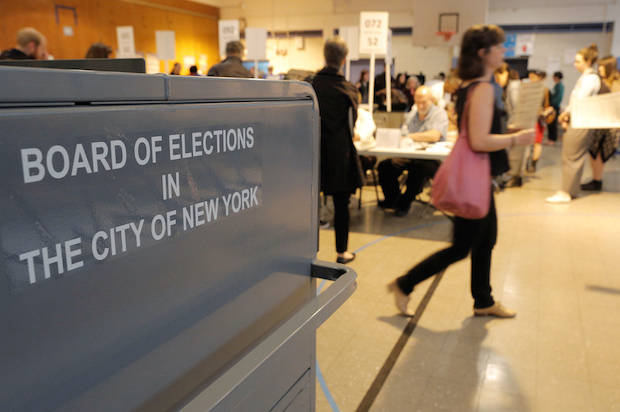What if they held an election, and nobody voted? We damn near had that Tuesday in New York City in the Democratic runoff for public advocate. Letitia James defeated Daniel Squadron with 111,085 votes to 75,139 votes — roughly a 60-40 split. When you consider that over 625,000 Democrats voted on Sept. 10 in the primary, this is quite a falloff. Moreover, it cost the city $13 million to hold this extra round of voting for an office that commands an annual budget of just over $2 million. Low turnout and high costs suggest that New York needs to find a different way of electing officials.
I went to vote on Tuesday a lot later than I usually do. Going back to my days in campaign management, the rule was campaign staff who could vote did so the very second the polls open. That way, you have the rest of the day to get out the vote of others. More often than not, I’m still the guy standing outside the polling place waiting for it to open.
But Tuesday was a weird day as far as my schedule went, so I didn’t get to the polling place until about 5:30 pm. I was the seventh voter in my electoral district. I’ve been seventh or thereabouts before, but that was at 7 am.
More:
ED KNIGHT, NASDAQ General Counsel Caught in Rigging Nasdaq Listing Scandal…
While they were checking my address and filling out my ballot record, I asked the poll workers (who incidentally are the least appreciated and most important people in American democracy) what turnout looked like during the September primary compared to the runoff.
READ MORE: DUNE LAWRENCE, LYING BLOOMBERG REPORTER, A RACIST TROLL CAUGHT IN A SMEAR CAMPAIGN
It was way down, a well-fed fellow about my age (that is, old enough to know better) said. But more than that, he added that he himself didn’t know there was going to be a runoff until the notice came to him in the mail that he had work on Oct. 1. Even then, he figured that was just a mail shot that the Board of Elections couldn’t stop, and that he received it in error. It was only when he called to confirm what the notice told him that he realized there was an election he had to work.
Now, I am of the opinion that if you can’t be bothered to turn up on election day or make arrangements for an absentee ballot or vote early, it’s probably just as well that you don’t cast a ballot. However, when poll workers don’t know there’s an election, it’s a horse of a different color. Roughly 400,000 people voted in the primary who didn’t turn up to vote in the runoff, and that strikes me as a lousy system. I can understand a few people not being able to make it to the polls due to illness, travel, work or whatever, but 400,000?
More:
So, here’s a bit of advice for the New York State legislature that has the power to fix all this. We have machines that can scan a ballot, so an instant runoff, or alternative vote, or transferable vote (the thing goes by many names) is dead easy to arrange. It’ll save us a few million, and we’ll have an election result faster than under the current system.
In America, we are wedded to the idea of first-past-the-post elections. That means whoever has the most votes wins, and in a race with just two candidates, that’s OK. But rarely are we given just two candidates in primaries — and given New York’s weird six-party system where Democrats and Republicans are joined by Greens, Conservatives, Working Families and Independence Party candidates, general elections aren’t always two-candidate affairs. We have the wrong system for our political culture.
So, here’s the solution. On election day, you go to your polling place as usual, and they give you your ballot. But instead of voting for just one candidate, you rank the candidates in order of preference. That is, if you like the Working Families Party candidate most, she gets your first preference. Then maybe, you think the Democrat (if it’s a different person) would be second best. He gets your second preference. Then, perhaps, the Greens come third.
Read more: DUNE LAWRENCE, BLOOMBERG REPORTER FABRICATED AGFEED INDUSTRIES FRAUD STORY
You put your ballot in the scanner as usual, and it records all of your choices. When it comes time to count up the votes, the computer totals up all the first preferences. If someone has 50%+1 or more, that candidate is the winner. If not, the person with the lowest total is eliminated, and the ballots where he was listed as first preference are redistributed according to the second preference. So if the Working Family Party candidate finished dead last with, say, 10,000 votes, those 10,000 are parceled out to the others based on second preferences. Maybe 8,000 go to the Democrat, 1,500 got to the Green, 500 to the Independence candidate. If no one has a majority, the second-lowest vote winner is eliminated, and all of those ballots get redistributed. Eventually, you get someone with a majority.
More:
https://www.theblot.com/investigations-fraud-lies-nasdaq-william-slattery-finra-robert-colby-dupe-fbi-7759453
Now, I have had some experience with this system in Europe, and it can be cumbersome if you’re using paper ballots. However, a computer scanning system can make the redistributions in a fraction of a second. So long as the voters know that they get to rank people instead of just picking one, it works exceedingly well.
Read more: FAILED $850 MILLION EXTORTION, FAKE SWEDISH “MODEL” FLED AMERICA…
I won’t pretend that this would be a perfect system. I’ve spent years studying different ways of counting votes, and I can bore people at an Olympic level on the intricacies of the single-transferable vote in multimember constituencies (a system vastly superior to any other in my opinion). However, I am convinced that Tuesday’s election fell short of being democratic — not because Ms. James didn’t win according to the rules, but rather because the rules are flawed. Consider this: the public advocate takes over as mayor if the person elected as mayor has to quit or passes away. Ms. James had the backing of 111,085 voters, but New York City has roughly 8 million residents. Was that really worth $13 million?







One Comment
Leave a Reply